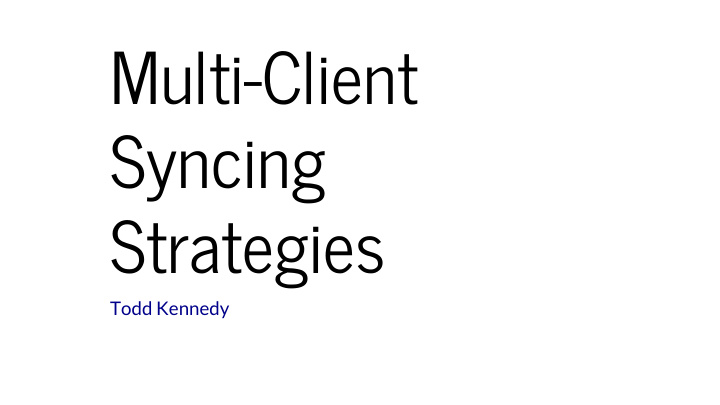



Multi-Client Syncing Strategies Todd Kennedy
> whoami Todd Kennedy @whale_eat_squid CTO, Scripto Beard grower
We have a problem We want to be able to let multiple people edit the same document ...but merge conflicts are bad
Luckily there are solutions Operational Transform (Google Docs, Wave, Etherpad) Differential Synchronization (O.G. Google Docs, Gedit) Conflict-Free Replicated Data Types (RIAK, Soundcloud)
Differential Synchronization Neil Fraiser at Google in 2009 (white paper) Original concept for google docs Uses a character based diff to traffic changes
A basic example In a basic, non-networked setup, there are two copies of the text that may be edited at anytime: the copy you're actively working on and the copy stored in your datastore. 1. Each operation in the active copy is diffed against a shadow copy, creating a diff 2. This diff is handled to the datastore 3. The current version of the active copy becomes the shadow copy 4. The diff is applied as a patch against the datastore
Simple, huh? Keeping muliple remote clients in sync requires 5 copies PER user
Whats good? Much simpler than OT & CRDT (for various definitions of "simplier") Allows for out of order application of changes Can work without central server
Whats bad? Scaling is complex & memory intensive Diff-Match-Patch is hard for structured data Can't track user performing edit in-band
Conflict-Free Replicated Data Types Two types of CRDTs
Commutative Replicated Data Types Operation-based Commutative but not idempotent Ops can arrive in any order, but must only arrive once
Convergent Replicated Data Types State-based Requires sending a lot data over wire (all state) Requires merge to be commutative, associative and idempotent
WOOT (WithOut Operational Transform A CRDT-based method for document editing
Whats Good Does not require a central server Less complex than OT (debateable!)
Whats Bad Can't delete data. Seriously, only hide it
Operational Transform Developed at MCTC in Austin, TX 1989 & Xerox Parc in 1995 & Google in mid 2000s
Serialization and broadcast of specific operations performed on a shared document of equal length, with respect to the document cursor
Basic operations insertCharacters deleteCharacters retain
Example Lets change "I like seattle" to "I like Seattle" retain(7) deleteCharacters('s') insertCharacters('S') retain(6)
So.... operations How do we use them though?
ENTER TRANSFORM The transform method is the heart of OT — it can apply operations on top of a document without requiring locking and resolving conflicts in a 'sane' fashion
Transform applies changesets to documents of the same length All the characters in the retain, insert & delete operations must add up to the length of the current document the transform is being applied to
A better example Two users editing a document that is the characters Ta User 1 inserts o User 2 inserts p Or, in transforms: retain(2), insertCharacters('o') retain(2), insertCharacters('p')
The document has changed in the client and the server, but to two different states. State A adds o to the document. State B adds p Now we need to reconcile the two states so that the unified document is in agreement again
Putting both changesets into the transform method returns two new changesets that can be applied to the current document state respectively const [a2, b2] = transform(a, b) ...but only because they're based on the same HEAD revision
transform returns an a2 that looks like: retain(3), insertCharacters('o')
Now we can apply to document state A and b2 to B and achieve singularity! By doing that to the document (which is now Tap) and we end up with Tapo!
Huh? Tapo isn't a word No, but it's a conflict-free resolution to the issue — better than git telling you that your head is detacted and you need a three-way merge! In a more complex scenario you'll be dealing with a lot more changesets with the same parent revision that will conflict. Most OT systems resolve this with a first-to-the-server strategy...
...since the server mediates the changesets between the clients
When the server accepts a commit message it assigns it a unique identifier (usually either a monotonically increasing integer or a SHA1 hash of the current document state). sends a accept message to the originating client broadcasts the change as to the rest of the connected clients
In reality... This is a way more likely scenario to encounter: the server and client are diverged by more than one state
Thankfully the transform method allows us to resolve for this state as well. In the simple example we discarded state b2 since the client was disinterested in it and only sent a2 to the server. Here, we need to use that to generate a new "bridge" transform.
By transforming b and a2 we can derive b2
And keeping with that, we can also transform b2 and a2 against c to get c2 which we can apply to this document. This "stepping" application can be applied on any number of changesets to derive any intermediate state so long as one shared revision exists.
That seems kind of laborious It is! Not only that but it's Big O is O(n log n) ! This complexity makes it difficult to support large numbers of clients performing operations on the same document.
Lets just compose ourselves Wave's improvement on this process is the compose function which is O(n) . Composes takes changesets performed on the same document and combines them into one changeset. So instead of transforming c against b2 and a2 we can compose the latter into ab2 and just transform(ab2, c)
Thank you!
Resources Concurrency Control in Groupware Systems High-Latency, Low-Bandwidth Windowing in the Jupiter Collaboration System Understanding and Applying Operational Transform Google Wave Operational Transform Neil Fraser's Google Tech Talk on Differential Sync WithOut Operational Transform WOOT for JavaScript and Scala Operational Transform JS Library Differential Synchronization
Recommend
More recommend